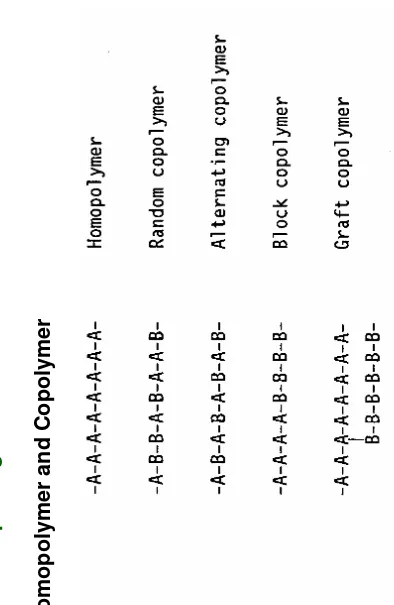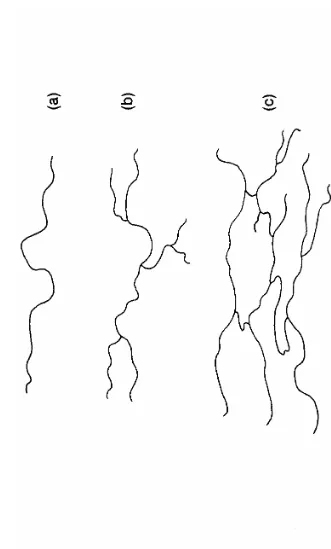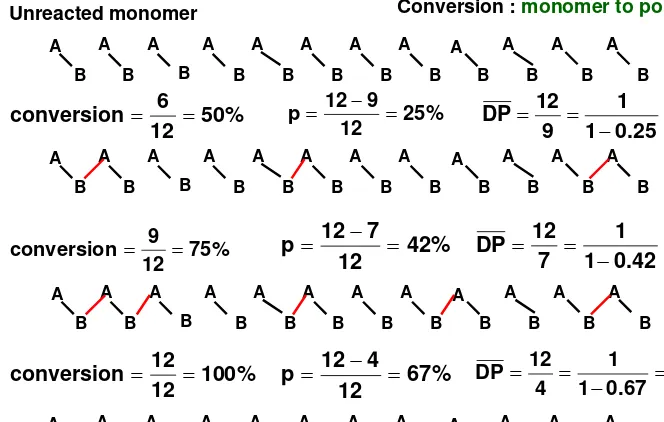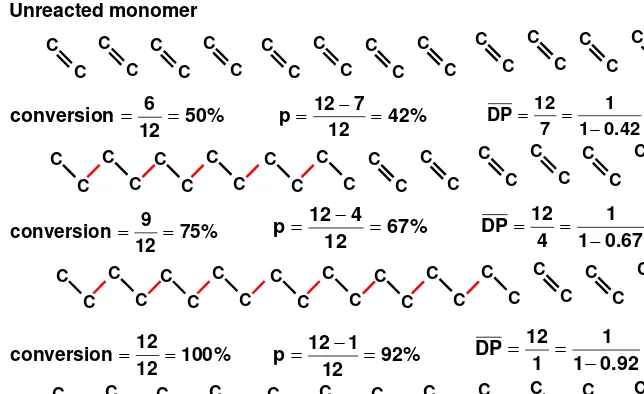Steel age [Industrial Revolution]
Silicon age and silica age [telecom revolution])
Polymer age
Human Nature
Machine Computer Brain
Material Semiconductor Macromolecules
Method Electricity Spirit
Polymer Science and Engineering
SCIENCE of
LARGE MOLECULES
SYNTHESIS:
linking of atoms
CHARACTERIZATION:
physical property
POLYMER PHYSICS AND PHYSICAL CHEMISTRY:
law of nature (thermodynamics)
Long Chain
Molecules
Extraordinary Range
of Physical Properties
What is a Polymer ?
—M— M— M— M— M— M— or — (M)n —
Many repeating units
A large molecule made up
of small building blocks (monomers)
POLYMER
MONOMERS Building blocks
HOMOPOLYMER What you get if the building
blocks are all the same
A polymer made up of different monomers
COPOLYMER
•
Synthetic
organic polymers
•
Biopolymers
(proteins, polypeptides, polynucleotides,
polysaccharides, natural rubber)
,
•
Semi-synthetic polymers
(chemically modified biopolymers)
•
Inorganic polymers
How Big are Polymers ?
Ethylene
CH2=CH2
Polyethylene
-(CH2-CH2)n
(covalent bonding)
mono + mer poly + mer
Greek
many part single part
Monomer ⇒ Oligomer ⇒ Polymer
B) Polymer Structure
1) Repeating Unit
a) Conventional Repeating unit depends on
monomer used in synthesis, e.g.
i) Polyethylene from Ethylene
C C H H H H C C H H H H n n
ii) Polymethylene from Diazomethane
CH2 N + -N n C H H
n + n N2
b) The Base Unit is independent to synthetic route and
= monomer unit
3) Living Polymers
a) Telechelic Polymers (reactive end groups)
tele + chele = far + claw
b) Reactive Oligomers
Oligomers containing reactive end groups
capable of undergoing polymerization,
C) Average Degree of Polymerization = DP
1) DP = # of repeating units in chain + # of end groups
2) DP = Average Degree of Polymerization
3) MW = DP x (MW of Repeating Unit)
4) CH3-(CH2)2000-CH3 has a DP = 2002
n CH
OCOCH3
CH2 CH
OCOCH3
CH2 n
poly(vinyl acetate)
(MW = 2000 x 86 = 172,000) vinyl acetate
(MW = 86)
C C C C C C C
e.g., vinyl polymers, polyacetylene, polysulfur, poly(dimethyl silane)
2) Heterochain polymer
contain more than one atom type in the backbone
C C O C C O C
E) Order of repeating units in backbone
1) Homopolymer (cf. Homochain Polymer)
made from a single monomer
(or pair of monomers in cases like polyesters, etc.)
2) Copolymer a) Synthesis
i) made from more than one type of monomer
ii) occasionally from more than one type of polymer
b) Types of Copolymers i) Random Copolymer
ii) Block Copolymer
iii) Alternating Copolymer
iv) Graft Copolymer
E) Order of repeating units in backbo
ne
1) Homopolymer
a
nd Copolymer
Fig
u
re
F) Conventional Polymer Structure Types
1) Linear
No branching other than the pendant groups associated with the monomer
2) Branched
may have only a few side chains or may be every few repeating units
3) Network (Crosslinked)
a) Crosslink density related to “hardness”
b) an average of more than two crosslinks per chain
⇒ infinite network
F) Conventional Polymer Structure Types
Network Formation
How
would you make chains that branch and then perhaps
interconnect to form networks?
A. Use a mixture of bifunctional and monofunctional units
B. Get a tube of
Molecular Super Glue
and stick a bunch
of chains together
ii) uses: viscosity modifiers in high performance engine oils
b) Dendrimer (also known as Starburst or Cascade Polymers)
i) generation numbers up to 5-7 ii) near spherical shapes
iii) steric crowding gradient
iv) uses: microencapsulation and drug delivery c) Comb
i) from Macromonomers such as 1-C20H40
2) Network
a) Ladder cf. DNA (see next page)
b) Semiladder (Stepladder)
3) Supramolecular
a) molecular superstructures held together by non-covalent bonds b) examples
i) Polyrotaxane
washers on a wire
ii) Polycatenane
Star polymer Comb polymer Ladder polymer
Semiladder polymer
(or Stepladder polymer) Polyrotaxane
Polycatenane
Dendrimer
compatibility and the degree of crosslinking
2) First “designed” crosslinking process is Vulcanization of rubber (Polyisoprene)
I) Thermoset Polymers
Example: Phenol-Formaldehyde resin (see next page)
a) Crosslinked network
b) One gigantic molecule
c) Insoluble
d) Non-melting
e) Only swell in a solvent
Thermoplastic Polymer (e.g., PE)
a) Linear, branched
OH + HC H O OH
H2 C
OH
H2 C
OH
H2 C
OH
C H2
Bakelite
The first true synthetic plastic
The hydrogens in the ortho and para positions to the OH group, which by convention are not usually shown but here are indicated by a , can react with fomaldehyde to form (initially) oligomers.
Network
Formation
Continued reaction builds up a densely
cross-linked network. This is Bakelite, a
thermosetting polymer.
Once the reaction is complete, the material cannot be reheated and reformed.
So, what do you think the definition of a
3) Rubbers (Elastomers)
4) Coatings
Information Technology Applications
•
Photoresists
for semiconductor
fabrication
for
microprocessor fabrication
•
Interlayer dielectrics
for
semiconductor
fabrication
fabrication
•
Alignment layers
for liquid crystal
displays
Alignment layers for liquid crystal displays
b) Determined by loss of weight (or not) on polymerization
2) Mechanistic Classification
a) Step-Growth (Step-Reaction) vs. Chain-Growth (Chain-Reaction)
b) Determined by reactive species
Condensation: Formation of byproduct, weight loss
Addition: No byproduct, No loss of weight
Step-Growth: All species grow step by step
Chain-Growth: Successive linking of monomers to
the end of a growing chain
HO OH + HOOC COOH HO O C COOH O
+ H2O
R + CH
G
CH2 CH
G CH2
R
Making a Polymer
The molecules are monofunctional;
To make linear chains we need bifunctional molecules;
Except the reaction doesn’t happen all in one go, like this, but in a
Making a Polyester
Note, reacting a
diacid
and a
dialcohol
will give you a
polyester
Types of Reactions
Condensation
Is a molecule of
water
b) Most monomer used up quickly but get high MW only near end
c) Wide MW distributions typical
2) Work out the DP & DP for the following
a) DP ≈ Number of repeating units in chain
MW = DP x (Repeating Unit MW)
b) DP = Average Number of repeating units in chain (plus the number of end groups)
MW = DP x (Repeating Unit MW)
DP = MW / Repeating Unit MW
c) p = reaction conversion = extent of reaction
i)
p = fraction of the original functional groups consumed
No = number of molecules initially
N = number of molecules finally
where o o
N
N
N
p
=
−
or N = No(1 - p)p 1 1 N N DP o − = = ii)
p = 0 at start when no polymerization
p ≈ 1 when polymerization complete (the numerical value
of p gets closer to 1 at higher final MW)
- very precise reaction stoichiometries
Figure 1.4
i) Step Reaction Polymerization of monomer A-B
ii) Show how polymerization effects array of A-B monomers
iii) Shows how even as p approaches 1, the average chain length
stays low
iv) Only at very end when almost no low MW species present
Figure 1.4 Step-reaction polymerization Unreacted monomer A B A B A B A B A B A B A B A B A B A B A B A B A B A B A B A B A B A B A B A B A B A B A B A B
Conversion : monomer to polymer
33 . 1 25 . 0 1 1 9 12 DP = − = = % 50 12 6
conversion = = 25%
12 9 12
p = − =
A B A B A B A B A B A B A B A B A B A B A B A B 71 . 1 42 . 0 1 1 7 12 DP = − = = % 75 12 9
conversion = = 42%
12 7 12
p = − =
A B A B A B A B A B A B A B A B A B A B A B A B % 100 12 12
conversion = = 67%
12 4 12
p = − = 3
Note;
you only get
high molecular weight polymer
at high degrees of conversion.
= DP
= degree of polymerization = number of repeating unit
n
What Are Polyolefins?
The term polyolefin embraces all polymers that are derived from
simple unsaturated aliphatic hydrocarbons that contain one
double bond per monomer. Examples include:
The most important polyolefins in terms of production volume are
polyethylene (PE), polypropylene (PP) and the ethylene/propylene
copolymers (EP).
Other significant polyolefins include, polybut-1-ene,
a) Chain Initiation Step(s)
Generation of highly reactive species, e.g.
- Free radical intermediate
- Carbocation or carbanion
- Transition metal species
b) Chain Propagation Step(s)
Increase MW by adding monomers to end of growing chain
c) Chain Termination Step(s)
Consume the active species by recombination, etc.
d) Chain Transfer Step(s)
3) Commonly found when have highly reactive intermediates
Free Radicals, Carbocations, Carbanions, etc.
4) Examples
a) FR Polymerization of Ethylene
C C H
H
H
H
R C C
H H H H n n R +
b) Nucleophilic Polymerization of Ethylene Oxide (Ring Opening)
RO- + CH2 CH2
O
-c) Even at low values of p (reaction conversion),
Figure 1.5 Chain-reaction polymerization C C C C C C C C C C C C C C C C C C C C C C C C C C C C C C C C C C C C C C C C C C C C C C C C C C C C C C C C C C C C C C C C C C C C C C C C Unreacted monomer % 50 12 6
conversion = = 42%
12 7 12
p = − = 1.71
42 . 0 1 1 7 12 DP = − = = % 75 12 9
conversion = = 67%
12 4 12
p = − = 3
67 . 0 1 1 4 12 DP = − = = C C C C C C C C C C C C C C C C C C C C C C C C % 100 12 12
conversion = = 92%
12 1 12
Chain Polymerizations
Characteristics of Chain Polymerizations
Chain Polymerizations–
Types
(nature of the
active site
)
Free Radical
Anionic
Cationic
Free Radical Polymerization
Free Radical Polymerization
Free Radical Polymerization
Short Chain Branching in Polyethylene
Formation of
short chain
branches
b) diisocyanates (OCN~R~NCO) + diamines (H2N~R’~NH2)
→ polyurea
-(CONH~R~NHCONH~R’~NH)-c) Diels-Alder reaction of 1,6-bis(cyclopentadienyl)hexanes with benzoquinone
CH2
6 +
O
O
6
O
O CH2
2) Chain-Reaction Condensation
Polymerization of CH2N2 initiated by BF3
CH2 +
CH2N2 N2
Polyurethanes
A reaction that does
not
involve the
splitti
ng out
of a small
2) Polyaddition: addition + step-reaction
No byproducts
Step-reaction polymerization
3) Chain polymerization: addition + chain polymerization
No byproducts
Chain-reaction polymerization
4) Condensative chain polymerization: condensation + chain-reaction
1.7 Nomenclature
IUPAC name
1) The smallest constitutional repeating unit (CRU) is identified
2) Substituent groups are assigned the lowest possible numbers
3) The name is placed in parenthesis, and prefixed with poly
1.7.1 Vinyl polymers
poly + monomer name
C H2C H2
Source name
= common name IUPAC name
polyethylene poly(methylene)
CF
2CF
2CH2 CH
polytetrafluoroethylene
polystyrene
poly(difluoromethylene)
poly(1-carboxylatoethylene)
CH2CH COOH
poly(acrylic acid)
CH2C CH3
poly(1-methyl-1-phenylethylene) poly(α-methylstyrene)
poly[1-(1-propyl)ethylene]
CH2CH
CH2CH2CH3
Source name
= common name IUPAC name
H2C CH CH CH2
CH2 CH2
CH CH2
1,2-addition
CH2CH CHCH2
1,4--addtion
1,3-butadiene
1,2-poly(1,3-butadiene)
1,4-poly(1,3-butadiene)
Poly(1-vinylethylene)
Poly(1-butene-1,4-diyl)
Poly[styrene-co-(methyl methacrylate)] Copoly(styrene/methyl methacrylate)
Poly[styrene-alt-(methyl methacrylate)] Alt-copoly(styrene/methyl methacrylate)
Polystyrene-block-poly(methyl methacrylate) Block-copoly(styrene/methyl methacrylate)
Polystyrene-graft-poly(methyl methacrylate) Graft-copoly(styrene/methyl methacrylate)
1.7.3. Nonvinyl Polymers
Polyethers, polyesters, polyamides
Heteroatoms Seniority: O, S, N, P
1) Polyethers
IUPAC name Source name
H2C CH2 O
CH2CH2O
CH2O
CH3CHO CHO
CH3 CH2O
O O
OCH2CH2C O
HO CH2
9
O
OH
O
HO2C CO2H
+ O C O oxy ethylene oxy terephthaloyl O(CH2)9C
HOCH2CH2OH
OCH2CH2OC
3) Polycarbonate O C O O C CH3 CH3
Bisphenol A polycarbonate
poly(oxycarbonyloxy-1,4-phenyleneisopropylene-1,4-phenylene)
Heteroatoms Seniority: O, S, N, P
4) Polyamide
N H O
C NH(CH2)5 O
Polycaprolactam = nylon 6
Poly[imino(1-oxohexane-1,6-diyl)]
NH(CH2)10 C O H2N(CH2)10COOH
Poly(undecanoamide) = nylon 11
Poly[imino(1-oxoundecane-1,11-diyl)]
caprolactam
C O C Cl O Cl +
H2N NH2
C O C O HN NH Terephthaloyl chloride m-Phenylenediamine Poly(m-phenyleneterephthalate) Poly(imino-1,3-phenyleneiminoterephthaloyl)
H2N(CH2)4NH2
+ NH(CH2)4NH
ClO2S SO2Cl
O2S SO2
Tetramethylenediamine
m-Benzenedisulfonyl chloride
Poly(tetramethylene-m-benzenesulfonamide)
1.7.4 Nonvinyl copolymers
IUPAC source-based nomenclature for nonvinyl copolymers
2:1:1 –molar ratio of the monomers
ethylene glycol, terephthalic acid, and isophthalic acid
poly(ethylene terephthalate-co-ethylene isophthalate)
6-aminohexanoic acid + 11-aminoundecanoic acid
poly[(6-aminohexanoic acid)-co-(11-aminoundecanoic acid)]
poly[(6-hexanoamide)-co-(11-undecanoamide)]
COOH
HOOC HOOC COOH
HO(CH2)2OH + +
O(CH2)2O C O
C O
O(CH2)2O C O
C O
H2N(CH2)10COOH H2N(CH2)5COOH +
α-Hydro-ω-hydroxypoly(oxyethylene)
1.7.6 Abbreviations
1.8 Industrial Polymers
Plastics weigh less and are more corrosion resistant than metals
Lower energy process
Five major classifications of the polymer industry
Plastics Fibers
Rubber (elastomers) Adhesives
forces (primarily Van der Waals, dipole - induced dipole, and
dipole-dipole ∴ need relatively high MW to get desired
strengths, etc.
2) Engineering plastics
a) Lower volume and higher cost
b) Superior mechanical properties and greater durability
c) Mostly Heterochain polymers
Hydrogen-Bonds hold even relatively short chains together very strongly
p26
TABLE 1.4 Five Major Commodity Plastics
Type Abbr
Low-density polyethylene
eviation Major Use
LDPE Packaging film, wire and cable insulation,
toys, flexible bottle, housewares, coatings
High-density polyethylene
Bottles, drums, pipe, conduit, sheet, film, wire and cable insulation
HDPE
Automobile and appliance parts, furniture, cordage, webbing, carpeting, film packaging
Polypropylene PP
Construction, rigid pipe, flooring,
wire and cable insulation, film and sheet
Poly(vinyl chloride) PVC
Packaging (foam and film), foam insulation, appliances, housewares, toys
PS
Polystyrene
Low-density: < 0.94 g/cm3, branched
Linear and Branched Polyethylenes
Low Density Polyethylene
a) Polyamide: nylon 6, nylon 66
b) Polyester: poly(ethylene terephthalate (PET), poly(butylene terephthalate (PBT)
c) Polycarbonate (PC)
d) Acetal: Polyoxymethylene (POM) = polyformaldehyde
Poly(methyl methacrylate) (PMMA)
An beautifully clear glassy material
‘Plexiglas’ or ‘Perspex’
Cockpit canopies for military aircraft
TABLE 1.6
Thermosetting Plastics
p28Major Use Type Abbreviation
Phenol-formaldehyde PF Electrical and electronic equipment, automobile parts, utensil handles,
plywood adhesives, particle board binder
Urea-formaldehyde UF Similar to PF polymers, treatment of textiles (crease-resistant), coatings
Melamine-formaldehyde MF Similar to UF polymers, decorative panels, counter and table tops, dinnerware
Unsaturated polyester UP Construction, automobile parts, boat hulls, marine accessories,
corrosion-resistant ducting, pipe, tank, etc., Business equipment
Epoxy Protective coatings, adhesives,
electrical and electronics applications,
Cellulosic
Acetate rayon Cellulose acetate
HO H HO H OH H O O H H O OH Cellulose
Polyester ; PET
Nylon ; nylon 66, nylon 6, aromatic polyamide Olefin ; PP
Acrylic ; polyacrylonitrile
Viscose rayon Regenerated cellulose
Noncellulosic
Cell-OH + (CH3CO)2O → Cell-OCOCH3 + CH3COOH
Cell-OH + CS2 + NaOH → Cell-O-C-S- Na+ + H 2O
=
Cell-O-C-S- Na+ → Cell-OH + CS2 + Na+
=S
S
1.8.3 Rubber (Elastomers)
TABLE 1.8 Principal Types of Synthetic Rubber
Type Description
Styrene-butadiene rubber (SBR) cis-1,4 polymer
EPDM for ethylene-propylene-diene monomer Trans-1,4 polymer, known as neoprene rubber Cis-1,4 polymer, “synthetic natural rubber” Copolymer of acrylonitrile and butadiene
Copolymer of isobutylene and isoprene
Polysiloxane
Linking polyethers through urethane groups Styrene-butadiene Polybutadiene Ethylene-propylene Polychloroprene Polyisoprene Nitrile Butyl Silicone Urethane Cl Cl
CH3 CH3
Si O CH3
CH3
HO OH + OCN Ar NCO
C Ar NCO
O O NH
O
C Ar NH
O
C
O O NH
O C O NH Ar OCN excess
OCN Ar NCO (unreacted)
H2N R NH2
C Ar NH
O
C
O O NH
O
C O
NH Ar HN R NH C NH
O
Buna S Rubber
poly(acrylate esters): exterior latex paints
Adhesives
Phenol-formaldehyde and urea-formaldehyde: Epoxides
Cyanoacrylate
wood industries
(plywood, particle board)
1.9 Polymer Recycling
TABLE 1.9 Plastics Recycling Code
2
HDPE
Number Letters Plastic
1 2 3 4 5 6 7 PETE HDPE V or PVC LDPE PP PS Other Poly(ethylene terephthalate) High-density polyethylene Poly(vinyl chloride) Low-density polyethylene Polypropylene Polystyrene
Others or mixed plastics
•
Solutions of polymer waste- Degradable polymer: landfill
- Combustible polymer: energy recovery
- Recycling
- Innovative uses: Automobile tires; ground and blended into




